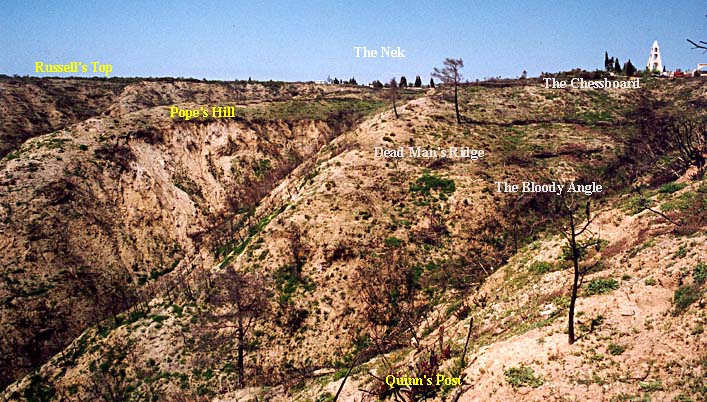The head of Monash Gully from the rear of Quinn's Post |
 |
Anzac positions are indicated in yellow, Turkish or no-man's land (The Bloody Angle), in white. Note that the Anzac line at the head of Monash Gully was not connected. A gap existed throughout the campaign separating Quinn's Post from Pope's Hill and another gap separated Pope's Hill (which was thus completely isolated), from Russell's Top. Dead Man's Ridge formed a salient into the Anzac line, and it was from this point and from Russell's Top that many men were killed by snipers in the first weeks of the campaign. These snipers had a clear view of the men coming up Monash Gully, and were able to look into the rear of such positions as Quinn's, Courtney's and Steele's Posts, and Maclaurin's Hill. See for example the records of Colonel H.N. Maclaurin, Major F.D. Irvine and Major-General W.T. Bridges, all killed by snipers operating from these positions. Gradually the Anzacs gained ascendancy over the Turkish snipers, largely through the work of Lieutenant T.M.P. Grace, of the Wellington Battalion, N.Z.E.F. Lieutenant Grace was in charge of a group of hand-picked riflemen who worked in pairs, and whose sole job it was to watch the Turkish positions, mark the sniping positions, and eliminate their fire. Lieutenant Grace died on Chunuk Bair on 8th August 1915. The monuments visible beyond the Chessboard are Turkish. Monash Gully was named after Colonel (later General Sir John) Monash, at the time, commanding officer of the 4th Australian Infantry Brigade. Monash Gully was a continuation of 'Shrapnel Valley'. Sir John Monash appears on the Australian hundred dollar note. Russell's Top was named after Brigadier-General Sir A.H. Russell, KCMG, Commanding Officer of the New Zealand Mounted Rifles Brigade. |